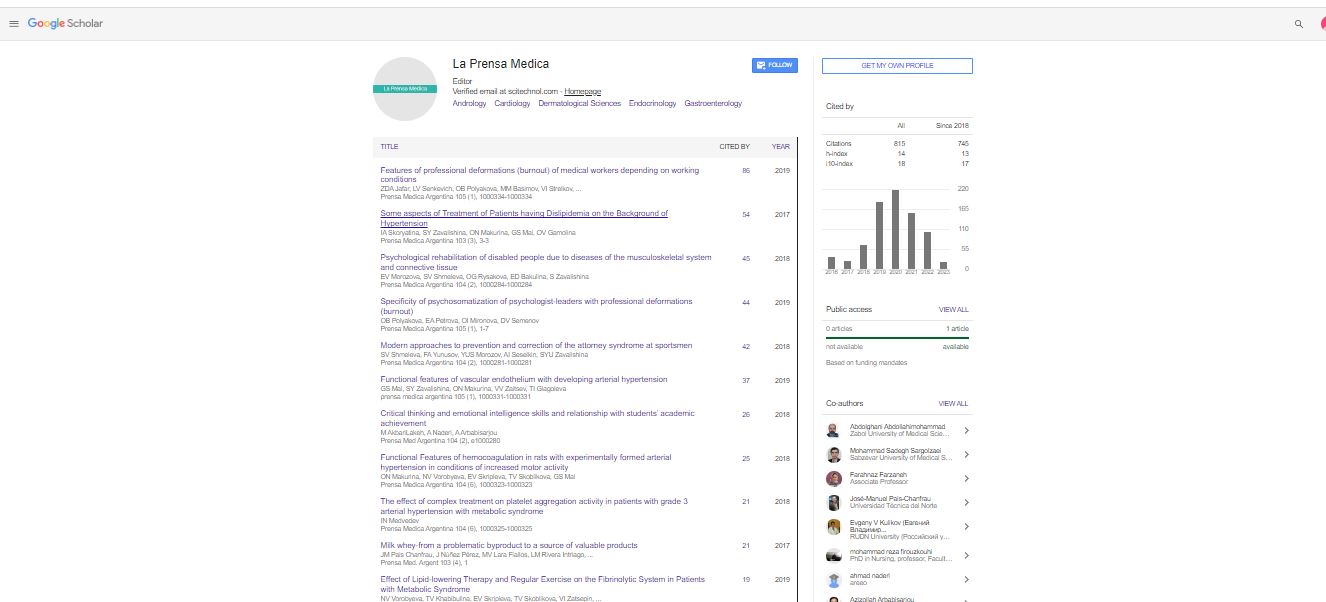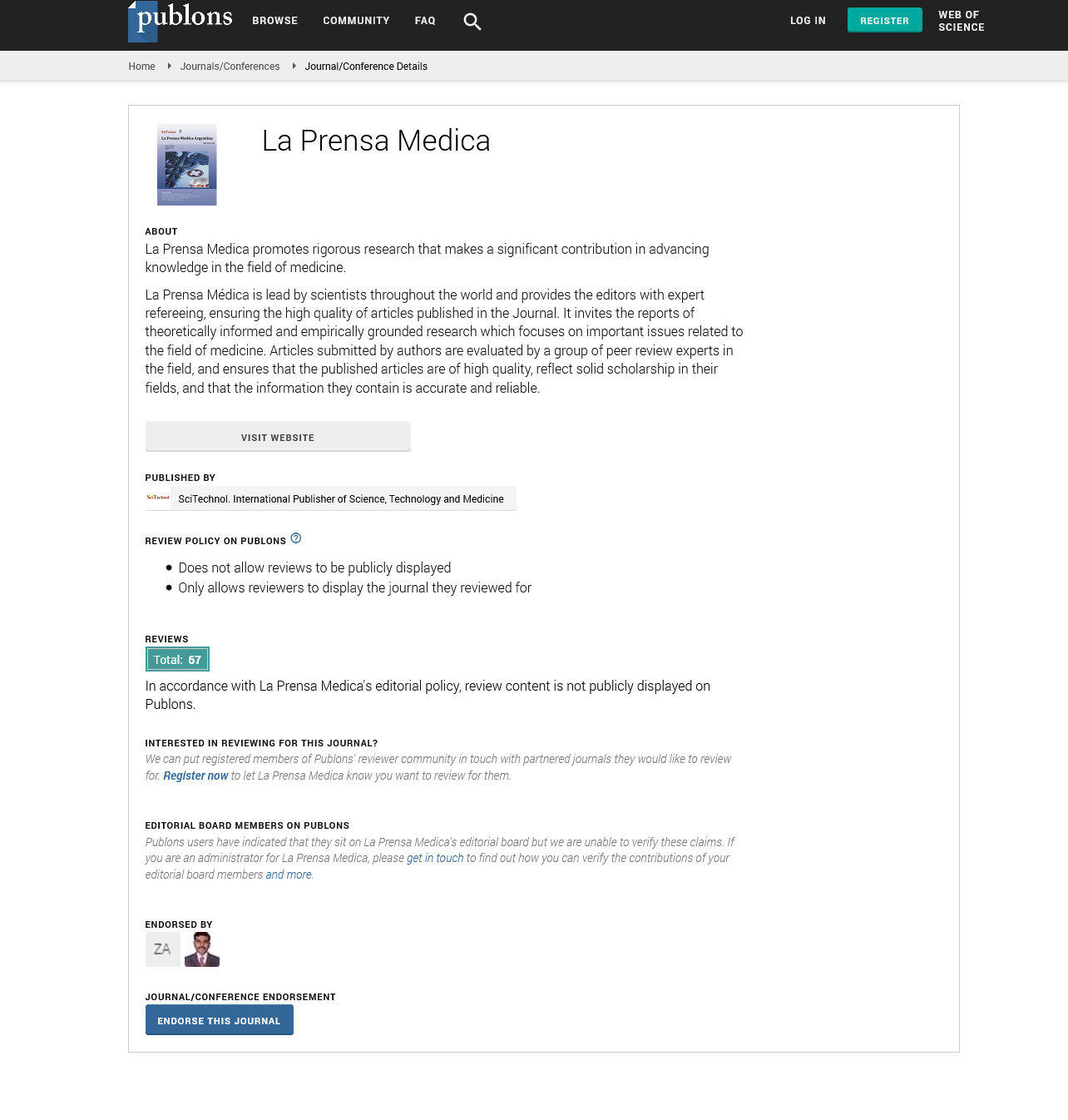Short Communication, La Prensa Medica Vol: 109 Issue: 3
The Fascinating World of Hematopoiesis and Stem Cell Biology
Osman Majeed*
Department of Laboratory Medicine, Umm Al-Qura University, Makkah, Saudi Arabia
*Corresponding Author: Osman Majeed
Department of Laboratory Medicine, Umm Al-Qura University, Makkah, Saudi
Arabia
E-mail: majeed1@moh.gov.sa
Received date: 29 May, 2023, Manuscript No. LPMA-23-107116;
Editor assigned date: 31 May, 2023, PreQC No. LPMA-23-107116(PQ);
Reviewed date: 14 June, 2023, QC No. LPMA-23-107116;
Revised date: 22 June, 2023, Manuscript No. LPMA-23-107116(R);
Published date: 29 June, 2023, DOI: 10.4172/0032-745X.1000169
Citation: Majeed O (2023) The Fascinating World of Hematopoiesis and Stem Cell Biology. La Prensa Medica 109:3.
Abstract
Description
Hematopoiesis is the complex process by which all blood cells are produced, developed, and replenished throughout life. This intricate process occurs in the bone marrow and involves the differentiation and maturation of Hematopoietic Stem Cells (HSCs) into various specialized blood cell lineages. Stem cell biology plays a pivotal role in understanding the mechanisms underlying hematopoiesis and holds immense potential for therapeutic applications [1]. This article explores the fascinating world of hematopoiesis and stem cell biology, shedding light on the intricate processes of blood cell formation and regeneration [2].
Hematopoiesis: A multistep process
Hematopoiesis begins with HSCs, located in bone marrow, which can give rise to all blood cell types. Cytokines, growth factors, and signaling molecules influence HSCs, leading to differentiation into Multipotent Progenitor Cells (CMPs and CLPs). CMPs differentiate into lineage-restricted progenitors for erythroid, myeloid, and megakaryocyte lineages. CLPs give rise to B cells, T cells, and natural killer cells [3]. Further maturation results in mature blood cells. Erythroid progenitors form red blood cells for oxygen transport, myeloid progenitors produce various white blood cells (granulocytes, monocytes, and platelets), and lymphoid progenitors give rise to immune response cells. Tight regulation maintains hematopoietic balance by managing self-renewal, differentiation, lineage commitment, and proliferation to ensure adequate blood cell production [4].
Hematopoietic stem cells and their properties
Hematopoietic stem cells are characterized by their ability to selfrenew, giving rise to more HSCs, while also differentiating into progenitor cells with restricted potential. They possess a unique combination of stemness and multipotency, making them indispensable for maintaining a constant supply of mature blood cells throughout life. HSCs can be identified and isolated based on specific cell surface markers, such as CD34 and CD133. Understanding the molecular and cellular characteristics of HSCs is influential for unraveling the mechanisms underlying hematopoiesis and harnessing their regenerative potential [5].
Regulation of hematopoiesis
Hematopoiesis, the process of blood cell formation, is tightly regulated to balance self-renewal and differentiation of Hematopoietic Stem Cells (HSCs). Signaling factors like cytokines and growth factors bind to HSC receptors, triggering intracellular pathways that govern proliferation and differentiation. The bone marrow microenvironment, or hematopoietic niche, comprising various cell types, plays a crucial role. Stromal, endothelial, mesenchymal, and immune cells secrete factors that maintain HSCs and influence their fate decisions. Notch receptors and ligands on HSCs and niche cells enable bidirectional signaling, influencing HSC development and maturation [6].
Dysregulation of hematopoiesis and hematological disorders
Dysfunction or dysregulation of hematopoiesis can lead to a range of hematological disorders. These disorders may arise due to genetic mutations, acquired mutations, or perturbations in the bone marrow microenvironment. Examples include leukaemia, myelodysplastic syndromes, and aplastic anaemia [7]. Understanding the underlying mechanisms of dysregulated hematopoiesis is deciding for developing targeted therapies and improving patient outcomes. Advances in stem cell biology and hematopoiesis research have provided valuable insights into the genetic and molecular basis of these disorders, paving the way for novel treatment approaches [8].
Therapeutic applications of stem cells in hematopoiesis
Stem cell biology holds tremendous therapeutic potential in the field of hematopoiesis and blood disorders. Hematopoietic Stem Cell Transplantation (HSCT), also known as bone marrow transplantation, has been widely used for the treatment of various hematological disorders, including leukaemia, lymphoma, and inherited bone marrow failure syndromes [9]. HSCT involves the infusion of healthy donor HSCs into a patient, which can then repopulate the bone marrow and restore normal hematopoiesis. Ongoing research focuses on improving the success and safety of HSCT, exploring alternative sources of stem cells, and developing gene and cell-based therapies for hematological disorders [10].
Conclusion
Hematopoiesis and stem cell biology play a pivotal role in the formation, development, and regeneration of blood cells. The complex process of hematopoiesis, driven by the intricate interplay of HSCs, cytokines, growth factors, and the bone marrow microenvironment, ensures the continuous production of mature blood cells throughout life. Dysregulation of hematopoiesis can lead to various hematological disorders, emphasizing the importance of understanding the underlying mechanisms for improved diagnosis and treatment. Stem cell biology offers encouraging therapeutic applications in the field of hematopoiesis, including hematopoietic stem cell transplantation and gene/cell-based therapies.
References
- Nielsen JS, Doyonnas R, McNagny KM (2002) Avian models to study the transcriptional control of hematopoietic lineage commitment and to identify lineage-specific genes. Cells Tissues Organs 171(1):44-63.
- Kulessa H, Frampton J, Graf T (1995) GATA-1 reprograms avian myelomonocytic cell lines into eosinophils, thromboblasts, and erythroblasts. Genes Dev 9(10):1250-1262.
- C.J. Eaves (2015) Hematopoietic stem cells: concepts, definitions, and the new reality. Blood 125(17):2605-2613.
- M.J. Hossain, L Xie (2015) Sex disparity in childhood and young adult acute myeloid leukemia (AML) survival: evidence from US population data Cancer. Epidemiol 39(6):892-900.
- HT Kim, MJ Zhang, AE Woolfrey, A St Martin, J Chen, et al. (2016) Donor and recipient sex in allogeneic stem cell transplantation: what really matters. Haematologica 101(10):1260-1266.
- HR Heo, L Chen, B An, KS Kim, J Ji, et al.(2015) Hormonal regulation of hematopoietic stem cells and their niche: a focus on estrogen. Int J Stem Cells 8(1):18-23.
- Y Liang, G Van Zant, SJ Szilvassy. (2005) Effects of aging on the homing and engraftment of murine hematopoietic stem and progenitor cells. Blood 106(4):1479-1487.
- Gregory CJ McCulloch EA Till JE (1973) Erythropoietic progenitors capable of colony formation in culture: state of differentiation. J Cell Physiol 81(3):411-420.
- Hodgson GS Bradley TR (1979) Properties of haematopoietic stem cells surviving 5-fluorouracil treatment: evidence for a pre-CFU-S. cell Nature vol. 281(5730): 381-382.
- Magli MC, Iscove NN, Odartchenko N. (1982) Transient nature of early haematopoietic spleen colonies. Nature 295(5849):527-529
 Spanish
Spanish  Chinese
Chinese  Russian
Russian  German
German  French
French  Japanese
Japanese  Portuguese
Portuguese  Hindi
Hindi 

